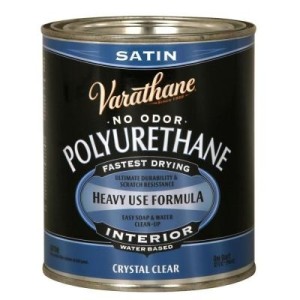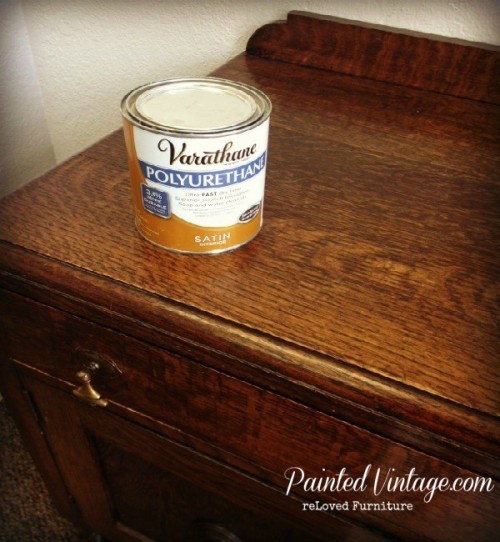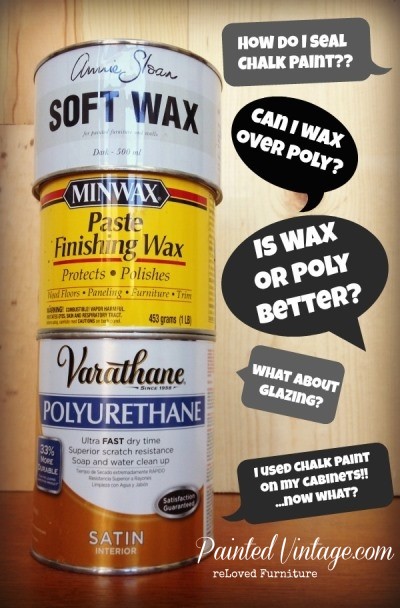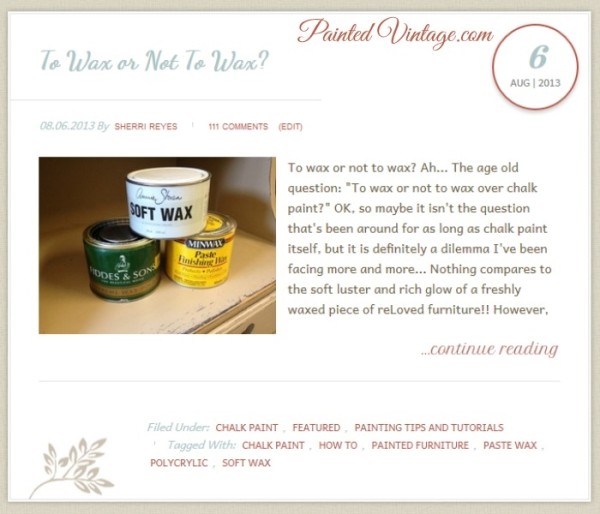Wax or Polycrylic over chalk paint?
All your questions about using wax vs. polycrylic over chalk paint answered!
The response has been overwhelming to my post on using wax or polycrylic over chalk paint (you can read the original post here: To Wax or Not to Wax?)
So, I decided to post an update with answers to your most frequently asked questions on applying a finish over chalk paint and wax alternatives.
Should I use a wax OR polycrylic over chalk paint? The answer really depends on how you will use the piece of furniture and how much time you are willing to invest in maintaining the finish. As I explained in my original post To Wax or Not to Wax? while waxing over chalk paint (or any variation of chalk style paint such as clay paint, mineral paint, and even DIY chalk paint) gives you a gorgeous velvety luster, it is NOT A PERMANENT finish and must be reapplied frequently to maintain the look and the protection of the wax. So if you absolutely must have the waxed finish, be prepared to also bust out a big can of elbow grease every few months!
That’s where water-based polyurethane finishes come in. Known as polycrylics, these finishes are an excellent alternative to use over chalk paint, for several reasons. Mostly they offer more of a permanent, durable finish that does not need to be reapplied. They are not heat sensitive like waxes are and they do not need to be completely removed should you chose to repaint. Oh, and they do not require any special courses in correct application techniques!
So for me personally, polycrylic wins the wax vs. poly challenge, hands down as my go-to finish of choice over chalk painted furniture.
What kind of wax would you use? Honestly, I rarely wax over chalk painted furniture anymore. But occasions do arise when I will use waxes. I love Minwax Paste Finishing Wax. It’s easy to work with and buffs out to a gorgeous finish! Another big plus is that it’s easy to find!! If I am going to be using a dark wax, I like the Annie Sloan Soft Wax.
What type of clear sealer do you use over chalk paint? There are several brands of water based polycrylics available. Admittedly, I have not tried them all, but I have tried several. I really like the Minwax Polycrylic, and I also love ease of the Minwax Wipe-On Poly for small projects. But, my all-time favorite is Varathane Crystal Clear Water-Based Polyurethane.
 Varathane Crystal Clear Poly goes on a little milky, but dries clear and stays clear! I have NEVER had any issues with Varathane Crystal Clear yellowing, as some polycrylics can over white painted furniture. This is my go-to product when applying a polyurethane over WHITE chalk paint. It is getting harder to find this product. But depending on which state you live in, you can still order online from HomeDepot.com
Varathane Crystal Clear Poly goes on a little milky, but dries clear and stays clear! I have NEVER had any issues with Varathane Crystal Clear yellowing, as some polycrylics can over white painted furniture. This is my go-to product when applying a polyurethane over WHITE chalk paint. It is getting harder to find this product. But depending on which state you live in, you can still order online from HomeDepot.com
In my area, the Crystal Clear formula has been replaced with a white labeled can that just reads: Varethane Polyurethane. I have been using this product for several months, and so far **knocking this wood buffet** I seem to have the same results as the Crystal Clear formula. UPDATE 9/15/14: I contacted Rustoleum and have been told the white label can is NOT the beloved Crystal Clear Formula. So , while I have not experienced any yellowing, I just want to clarify, THIS IS NOT IS CRYSTAL CLEAR FORMULA.

I should point out that POLYCRYLIC generally refers to a water-based finish, and POLYURETHANE refers to an oil-based finish. Varathane calls both their water-based and oil-based formulas by the generic “Polyurethane” name. In this post, I am specifically referring to the water-based formula only. Oil-based polyurethanes WILL AMBER over time.
How do you apply the poly over chalk paint? Using a good quality synthetic brush (Purdy’s are my preference) apply the poly in the direction of the natural wood grain. Using long, even strokes, work in one direction only, and try not to “over work” it by going back and forth into the wet area. Allow it to dry a couple hours between coats. While it does not require sanding between coats, I will sometimes sand lightly with a brown paper bag (yes, the grocery / lunch sack kind) if I need to knock down any bumps or little ridges. This can also be done after to buff it out to a gorgeous shine.
I have already waxed over my chalk paint, can I just apply poly over the wax? No. If you have used wax, it must be completely removed prior to applying anything. You cannot apply polycrylic over a waxed surface. You see, as the wax dries it becomes a natural water repellant. WAX REPELS WATER. That’s what wax does. Therefore, the poly has nothing to adhere to, because the wax is busy doing its job of repelling… An easy rule of thumb to remember IF your are going to use wax: “WAX IS LAST”
“Wax is Last”
Now, I have read that Annie Sloan wax can be top-coated with a polycrylic. Besides ASCP, I have also heard other chalk style paint manufactures claiming that you can apply poly over wax. I personally will never recommend that, and neither do the polycrylic manufactures. The back of my can reads “surface must be free from wax before applying” in two different areas of the label.
What about painting over wax? Same concept as above applies. If you would like to repaint furniture that has already been chalk painted and waxed, you must remove the wax first. Paint will not adhere directly to the wax. Wax can be removed by wiping the surface down with mineral spirits. Once the wax has been removed, you can proceed with your project. (Now I personally, would still prime with Zinsser Cover Stain, but I’m old school that way.)
Again, I have heard Annie Sloan Chalk Paint and a few other chalk-style manufactures say you can apply chalk paint, clay paint, or mineral paint directly over wax. I personally, would never suggest this. My preferred method for painting over wax, is to remove the wax FIRST. (…annnnd I’d probably prime)
Can I apply wax over polycrylic? Yes, you can. If you want the durability of the poly, but the look of a wax, you can use them together AS LONG AS THE WAX IS THE FINAL COAT. Because of the nature of wax and the way it cures, I would suggest using a matte poly if you want a wax top coat. Allow it to dry completely before waxing.
Can I apply Dark Wax over poly? Yes. Remember the rule “Wax is Last” So if dark wax is going to be your last step, you can absolutely apply it over poly. If you have just painted furniture with chalk paint and you want to really bring out the details and give your piece some character, dark wax is a wonderful product. Apply the poly first, so the dark wax does not stain the porous chalk paint.
Can I glaze over the poly? Yes, you can. If you want to add a dark glaze over chalk paint, apply a light coat of poly so the glaze does not stain the porous chalk paint. You can then glaze on top, once the poly is dried. You’ll want to apply another coat or two of the poly after you’ve waited patiently for the glaze to completely dry- don’t rush the waiting part here… it’s important. Otherwise you’ll make a mess- just trust me…
Can I use Chalk Paint over the polycrylic? Yes, you can. That is one of the benefits of using a polycrylic vs wax. If you change your mind on the color, or simply want to repaint your furniture piece later on down the road, you can do that! The poly does not need to be removed.
What kind of sealer do you recommend for Chalk Painted kitchen cabinets? A polycrylic would be my preference. I would not use a wax for a few reasons. If you’re like me, your cabinets will need to be wiped down almost daily. Splashes, spills and tons of chocolatey little fingerprints may need to be scrubbed. Lots of heat from all the cooking and baking that may (or may not) be going on… Wax will wear down very quickly under those conditions and will need to be re-applied more frequently. Let’s face it, waxing kitchen cabinets is not high on my monthly to-do list of chores. If I am going to spend the time to redo kitchen cabinets, I only want to do it once, and forget it! I really don’t need frequent reminders of what hard work that can be!
What kind of sealer can I use on my kitchen table top? For the same reasons listed above, I would use a polycrylic. At least 4-6 coats would provide a gorgeous, durable finish that would hold up well under the use and abuse a kitchen / dining table may receive. If I really wanted a virtually indestructible finish, I’d go with the Varathane Floor Finish.
Disclaimer: Although I think I would be a heck of a great spokesperson… (are you listening @rustoleum??) I am not sponsored or compensated in any way by Varathane. I just love the brand and have used it for dozens of years, even back when it was called Diamond by Flecto.
I hope you will find my answers to these frequently asked questions helpful in your research about using wax or polycrylic over chalk paint. These are actual questions I have been asked by my readers, and the answers given are what I would do in a given situation, based on my personal experiences. If you’d like to read my original post, you can find it here:








Wonderful information on how to protect finish! Doing my homework first before reLoving some pieces.
Many thanks,
Kat
My dining table is my very first diy project. I went to home depot and bought all of my supplies. I sanded, primed and did 3 light coats of my color choice. Waited 24 hours between each coat. It looked beautiful all in a flat finish. I bought the minwax water based polycrylic and applied it just like the directions said. I feel that I ruined it because I’m simply not a pro. There are very noticeable brush strokes and I feel that a second coat will leave it the same. My question is: Is there a wax or maybe another product that I can use on top that will minimize the brush strokes and give me a satin finish or even semi gloss.? I dont want it super glossy. Please help! I’m desperate!
I read your comment after I just posted a similar one below. Did you ever find a solution on how to apply the poly without streaks? I would love to know!!!
I used the waterbased poly on my kitchen table, I did not find that it held up well. My daughter wrote on the table with crayola markers and I couldn’t get the marks out of the finish. I ended up refinishing the top in an oil based poly. It is holding up much better now.
As for the brush marks in the poly, do a light sand with steel wool in between coats of poly and make sure you wipe the surface after so you get any metal pieces up. I have heard you can put paint thinner on it to reduced the brush marks, but I have not done that. Also, make sure you use a really good brush, that makes all the difference.
Thank you Karen for your comments. Yes, the oil based poly is more durable than the water based.
And just to clarify, the paint thinner can only be used with an oil based poly and NOT the water based version.
Can you still write on the chalkboard and wipe clean to write on it again if you use a polycyclic on it?
Chalk paint and chalkboard paint are two separate things. Chalk paint is just a type of paint. Type in chalk paint into Pintrest.
Hi Sherri,
Love all your tips! Thanks you so much for taking the time to explain it all! One question though , how do you get a smooth finish with the Minwax polycrylic ? I have done a few pieces and it is so much work . I have always had to do at least 3 coats to get it even( sanding in between each coat ). I use a good brush and I find it hard to load the brush properly without getting drips or it drying to fast or brush marks. Just when I think I get the hang of it , something else happens . On one project on the 3 coat it raised the grain on my table and had to re sand and start all over . Waste of time and product . So decided to try the Minwax paste , I used a cloth and rubbed it in and then buffed it and now it doesn’t even look like it has a finish . Not sure what I am doing wrong. I think that’s more than one question – sorry :/
Hi Rachelle, Thank you so much!! With Polycrylics you do have to work fast- and NOT over work them. It is crucial to maintain a wet edge as you go along. Brush on a light coat and leave it! Your second coat will fill in any missed spots or holidays. Most people overwork it when trying to smooth out the brush strokes. This is causing it to dry faster, and therefore, not allowing it to level and fill in the brush marks. Also make sure the good quality brush you are using is a synthetic brush. Hope that helps!
Hi Sherri, I was just curious – wouldn’t using chalk paint and then satin poly have the same results as using a regular satin paint? Just wondering what the difference is, Thanks!
Hi Kari, Yes- similar results. By using a chalk paint, you are eliminating the need to sand or prime first.
I’m curious, if you poly over the chalkboard, will it still work like a chalkboard? I am working on a dining room table with a chalk board top and i was hoping to add a harder finish to the chalk board top while still keeping the ability to use it like a chalk board.
@frank, did you find out an answer to your question? I have the same concerns
@frank @kim Same here. I also am impressed how @melanie managed to do the “Blog Comment Pick-and-Roll-answer-a-different-question-asked” move.
To be clear: I have a wall with chalkboard paint, I want to use chalk pens on it, but don’t want them to stain permanently, so I’m looking to apply a sealant to chalkboard paint. I know this blog is about furniture, but my Google Overlords instructed me to come here, so hopefully someone can answer this.
While I have never used the clear polyurethane for this application, I would think it will not work. When you put a clear coating over the chalkboard paint, you have just covered up it’s chalk erasing capabilities. Since the poly is not meant to work with chalks pens, I would be concerned that they would stain the poly. However, I’m sure someone who has actually tried this will help us out.
Thanks for the input, Sherri!
Sherri is right! don’t try to seal a chalkboard paint finish…not necessary!
Ok…so I’m really frustrated b/c I read everywhere how easy chalk painting is and well…I failed somehow! I used Martha Stewart chalk paint & let it dry…so far I was good. Then I decided to use the glaze over it…well I mixed my glaze & as soon as my brush went over the paint some paint started to come off. I then took a soft rag to wipe the excess glaze off & it took all of my paint off?? What did I do wrong?? Any suggestions/advice welcomed!
First timer here. I chalk painted a dining table, love it, looks great, then I did a layer of wax, like the directions said to do. I read that the wax will need to be reapplied once a year or so, I figured that would be a fine amount of maintenance, no biggie. On went the wax, then I later read that highly used surfaces (dining tables for example) will need to be re-waxed much more often, ugh. I found you, didn’t know I could poly over chalk, but that is what I want to do now. Mineral spirits are what I am to use to take off the wax but I am concerned about the paint. Will it ruin the paint job???
You can definitely use Annie Sloan Chalk Paint over poly. You might want to rough it up a bit. I just did it. No sanding and have had zero issues. And ACSP can be used directly over wax. No problem and no sanding.
I don’t like the way the top of the desk looks….TOO streaky. Can I patch it by painting over the wax, then re-waxing?
Hi Julie- I would recommend removing the wax first, and then repainting. You can use paint thinner / mineral spirits to remve the wax.
I have decided to use the poly acrylic before I glaze and then apply another coat of poly acrylic. now I’m concerned is the glaze going to darken the spots around the lines and circles I distressed??? thanks for your quick response in the middle of steps number 10+ ;)))
If you are planning on using the dark wax to accent/distress kitchen cabinets but want more then a wax coating to protect them, what do you suggest? I read you don’t recommend poly over wax.
The wax would need to be the last step. So poly first, then wax.
Shabby Paints Vax is a great finishing product. It’s so easy to use and don’t have to reapply ever. It is very durable also non toxic. If your chalk painting table tops or kitchen cabinets, they also make a varnish that’s just as easy to use. Check out their website.
Hi Sherri! Thanks for all your info! I am redoing our kitchen island cabinets in black chalk paint & am trying to decide between wax & poly. I’ve read that poly over black matte can show ANY kind of imperfections similar to black paint on a car. Have you done any furniture using a black chalk paint & covered in a matte poly with success? We’ve tried Minwax Natural & Briwax & both left awful scratch marks from applying the wax plus they look oily or greasy, not that matte/softened effect in the un-waxed chalk paint. Ugh! Thank you again!
I am currently redoing a hutch in black chalk paint and am using a matte mineWax polyacrylic. So far the first two coats have shown brush strokes (or more like streaks!) I’m using the “best” brushes that were recommended and I’ve sanded lightly between the two coats so I’m hoping the third coat will be the charm. I’m interested to hear any tips on working with darker colors and poly as well.
If I’m planning on using stain to glaze over chalk paint, should it be specifically a water based stain, or will an oil based stain get the job done? Thanks!